What I’ve Been Playing (Q2) 2021
Thoughts and impressions on the games I completed/rolled the credits on during the months of April thru June (Q2 2021).
 UnexpectedGames
UnexpectedGames
Just a friendly bear who works in financial reporting that would rather be playing, writing or talking about video games. https://twitch.tv/unexpectedenemy
Thoughts and impressions on the games I completed/rolled the credits on during the months of April thru June (Q2 2021).
If you’re not familiar with my writing, for the past few years I’ve been attempting to complete/roll the credits on 52 games during the year. My goal with these blog posts is to write a paragraph or two for each game I’ve beaten. There’s both an online forum community and a discord comprised of like-minded individuals who enjoy sharing their progress and impressions on the games they’ve completed throughout the year. During the second quarter of 2021, however, I became fully vaccinated. Although variants are on the rise, I’ve been dipping my toes back into society over these past few months and reconnecting with friends I haven’t seen since before the pandemic. Because of this, I haven’t completed as many games as I have in previous years, especially when compared against 2020 (which is perfectly fine). With that said, here are the games I did manage to beat during the months of April through June. If you’d like to see what I’ve completed during the first quarter of the year, you can read about that here! At the time of writing this, I am currently at 25/52 games beaten for the year.
Game #15. Balan Wonderworld isn’t great by any stretch of the imagination… but I sort of love it. Growing-up, like many kids born in the late 80s/early 90s, it was almost impossible to not have played Sonic the Hedgehog for the Sega Genesis. There’s home videos of me sitting on the carpet, glued to the TV at my aunt’s & uncles house playing the original Sonic as a child during the holidays. Years later, my parents were cool (and fortunate enough) to gift my siblings and I a Sega Saturn for Christmas with a handful of games, including NiGHTS Into Dreams. I loved the game so much for all of its weirdness and eccentricities that I found myself recording the game’s music from our old TV’s terrible speakers with a blank tape and a boombox. Years later, I would graduate to Sonic Adventure and the rest of Sonic Team’s releases long after Dreamcast’s (short) lifespan, including Billy Hatcher and the Giant Egg for the Gamecube. Needless to say, I approached the game with a degree of bias, so I knew I was going to enjoy Balan Wonderworld to an extent, but what about everyone else?
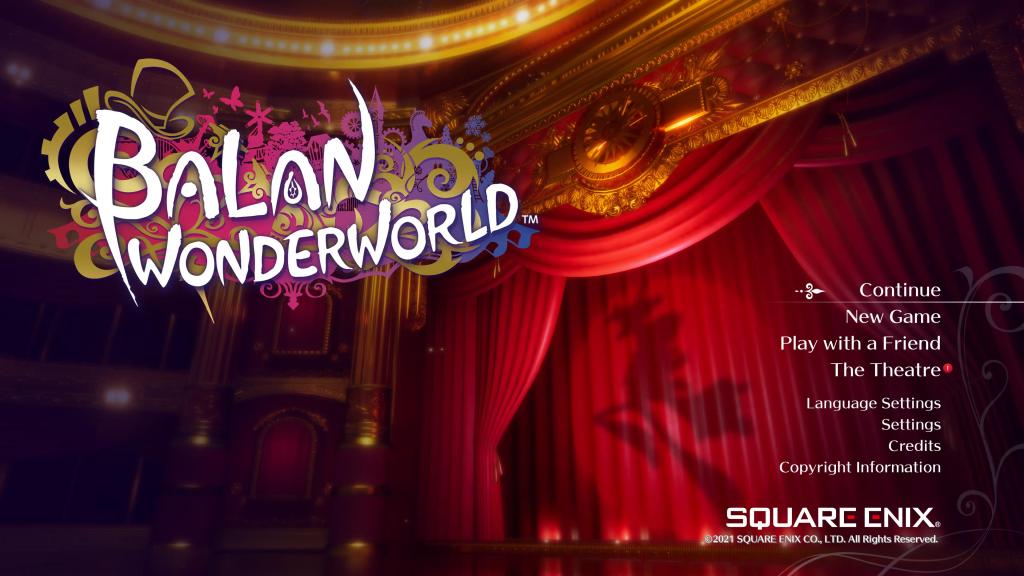
To no one’s surprise, Balan Wonderworld released to little fanfare and an almost universally heated reception. At its core, Balan Wonderworld is a 3D platformer with a heavy emphasis on collecting things. The gimmick? You have one button that does nearly everything in the game (including your jump), which has become one of the (many) focal points for the discourse surrounding its release. In each of the game’s numerous levels, you’ll also collect costumes which transform you into various characters. Each of these costumes typically grant you a new ability/power which lets you traverse the stage in unique ways or solve simple platforming puzzles/sequences. One costume might allow you to float short distances while another may grant you the ability to destroy specific blocks. The problem, however, is that some of these costumes don’t allow you to jump by default. Furthermore, you can only carry 3 costumes at any given time and once you get hit, you’ll lose that costume until you recollect it. The stages are mostly designed around a level’s costumes, but a lot of the time you’ll reach a platform or two that can’t be reached without something that allows you to perform the most simplest of actions. It’s certainly frustrating and a strange design decision no matter how you slice it, despite the levels mostly being design around this philosophy.
Similar to NiGHTS, the game has no dialogue and the cut-scenes and environment tell the little story that’s actually present. The game, once again, is about exploring the sub-conscious (or dreams?) of individuals who have experienced some sort of life hardship. There’s a dolphin trainer, for example, who had a bad experience while performing underwater, so their level is water-themed, including the boss, which is a nightmare-ish amalgamation of a dolphin. There’s even a professional chess player, who just happens to get defeated by someone younger than them (perhaps some would say is a metaphor for the game’s creator, Yuji Naka?) and the entire stage is a warped chess board of sorts. You get the idea. The game also has beautifully rendered CGI from Square Enix’s Image Studio Division (formerly Visual Works), which are quite well done. I really enjoyed the game’s minimalist approach, although it does leave many questions as to what you’re doing half the time for the people that you’re “saving”. There’s also a novel called Balan Wonderworld: Maestro of Mystery, Theatre of Wonders, which apparently goes more in-depth with the game’s story/characters. Some may appreciate this multi-media approach, but I’m personally not a fan of sharing your game’s vision through multiple forms of media (*cough* Final Fantasy XV *cough*).

If there’s one area where I believe Balan Wonderworld does excel in is that the stages do not overstay their welcome. It’s something I feel very strongly about; when it comes to 2D/3D platformers, give me short & sweet levels with some cool ideas, interesting mechanics, great music and I’m (usually) all-in. Unfortunately, Balan Wonderworld shows its cards very early-on, for better or worse. Each themed world contains two traditional platforming levels and a boss encounter. I’d like to think you’re in and out before any of the costume/stage mechanics become too frustrating, but your mileage may vary depending on your level of patience (which I have a lot of apparently). The bosses are the highlight of the game as they almost feel Mario-esque in design with their bouncy animations, unique mechanics and the fact that they take three hits to defeat. Balan Wonderworld ultimately feels like a lost Dreamcast era 3D platformer that fits right at home with the sixth generation of consoles, which is certainly not for everyone in 2021 and perhaps not the greatest selling point for a full-priced game (which at the time of writing this, the game can be purchased with a fairly hefty discount).

There is one element to the game that’s fairly inexcusable, however. There are bonus rounds/mini-games where you control Balan in quick-time-events (QTEs) and while they’re mostly optional, they’re truly miserable (especially if you’re going 100%). Perhaps due to budgetary reasons, I have no idea why the player couldn’t control this character and fly around the environments during these segments as that would have been the perfect tribute to NiGHTS, the game that inspired Balan Wonderworld to begin with! I completed the game with a decent amount of the collectables earned, but there’s quite a bit of content here and some post-game challenges if you like the game well enough. Balan Wonderworld has problems and it’s a project that could have been so much more than what we ultimately received. But does it deserve all of the negativity and social media dragging it’s received from the gaming community at large? Not really. Perhaps we’ll never know why the game released the way it did, but there’s a lot of heart and care on display here that’s hard to dislike. Regardless of how you may feel about the game, we’re likely never going to see a “AAA” style 3D platformer like this ever again (due to its lackluster sales and poor reception) and it honestly breaks my heart. See you in my dreams, Balan…
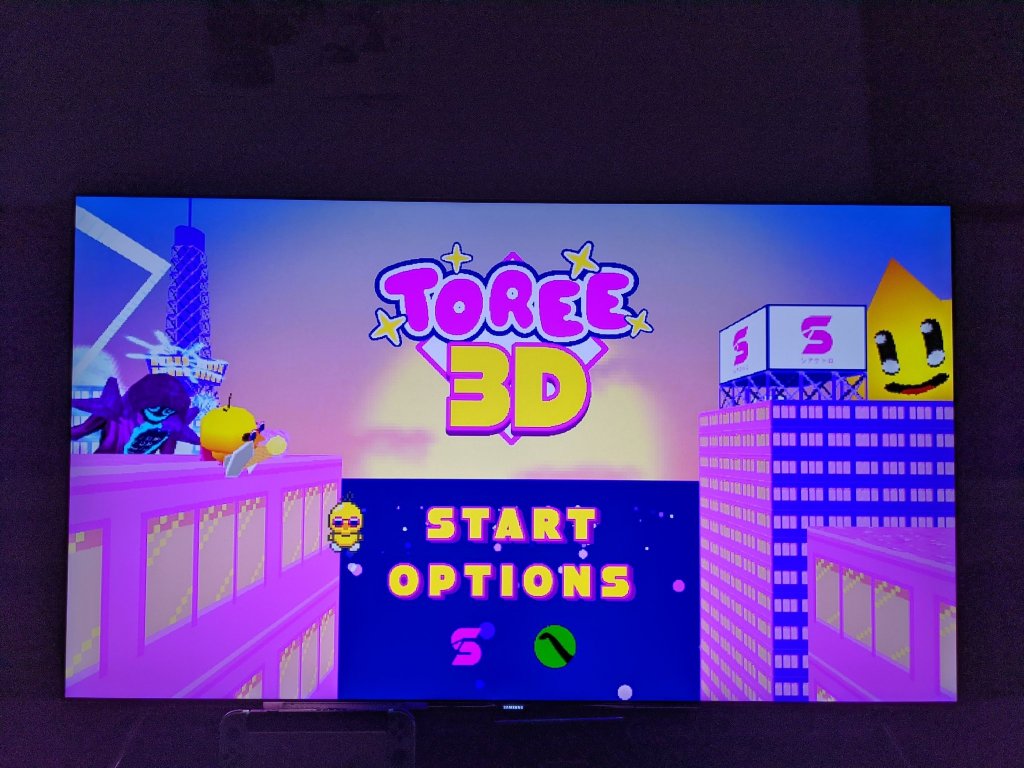
#16. Toree 3D, by Siactro, is the type of game you’d see someone speed-running at 2:30 in the morning during AGDQ/SGDQ. It’s an extremely short, 3D platformer from an indie studio that’s previously known for Macbat 64 (another 3D platformer that was specifically inspired by games like Banjo-Kazooie and Super Mario 64). Toree 3D is pretty bare bones, for better or worse; you simply start the game, select a character from three options (two of which who are locked by default), and then you’re given the option to tackle a handful of obstacle course-like stages in any order you’d like. Once you clear all of the levels, you’ll gain access to the final boss stage. The controls are a little floaty, but tight enough where you’ll find yourself cutting corners and mastering the stages if you decide to tackle the game’s time trials. The levels themselves feel like obstacle courses that have been suspended in air, with moving platforms, hazards and the like. There’s stars to collect in each level and “A Ranks” to earn based on how quickly you can complete the stages (which if collected/earned will unlock both secret characters, respectively). I believe I bought the game for $1 on the eShop, so you could definitely do worse.

Game #17. Sackboy: A Big Adventure, by Sumo Digital, is one of the best cooperative experiences I’ve had all year (next to It Takes Two, of course). It’s also the first time I’ve felt good about controlling Sackboy as I’ve never enjoyed the floaty controls from the previous 2D games. With its transition to being a 3D platformer, however, the controls feel much more fluid and less floaty than Media Molecule’s games, who were the original developers. I’ve also got a weakness for hand-crafted, arts & crafts styled visuals; games like Kirby’s Epic Yarn, Yoshi’s Woolly/Crafted World, and Puppeteer, just to name a few. There’s a craftsmanship here that’s hard to deny, each level feels meticulously detailed with a lot of love and care (there’s also great depth of field on display here which is something I always appreciate if done well). Taking a note from Rayman Legends, there’s also music levels which are arguably the highlight of the game. Playing these rhythmic stages cooperatively with friends, trying to guess which songs/artists were being remixed brought about tons of smiles and laughter. The soundtrack, as a whole, perhaps stands-out more than anything here, including the original compositions from a variety of composers (like Lena Raine, for example!).
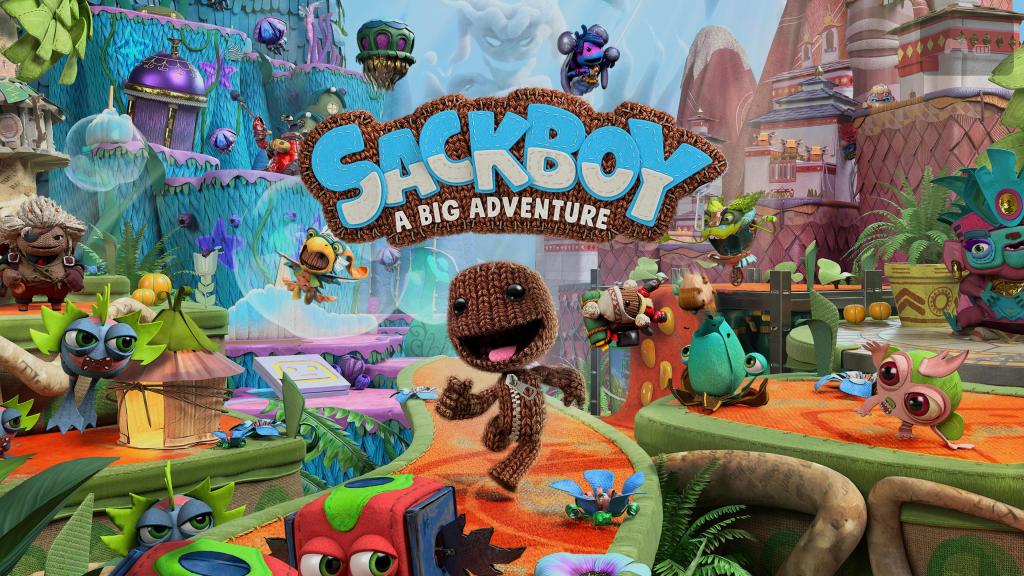
It’s hard not to compare the game to Nintendo’s Super Mario 3D World (which I wrote about last quarter). Sackboy is clearly designed around having four players traverse its many themed stages. Levels are laid out in such a way where paths will split into two segments and allow room for 2 players or more, so you’re arguably not getting the full experience if you go at it alone. While the game can be played completely solo from start to finish, there’s coop-only stages that must be completed if you’re a completionist, however. While the platforming challenges themselves aren’t anything you haven’t seen before, stages still feel varied with unique power-ups and secrets to discover and most importantly, they don’t overstay their welcome (which if you haven’t learned already is a huge pet peeve of mine when it comes to 2D/3D platformers). There’s a lot of content here if you’re one who likes to complete games at 100% (such as myself) including time trials with leaderboards if you’re looking to compete (they’re even adding timed challenges with rewards now).
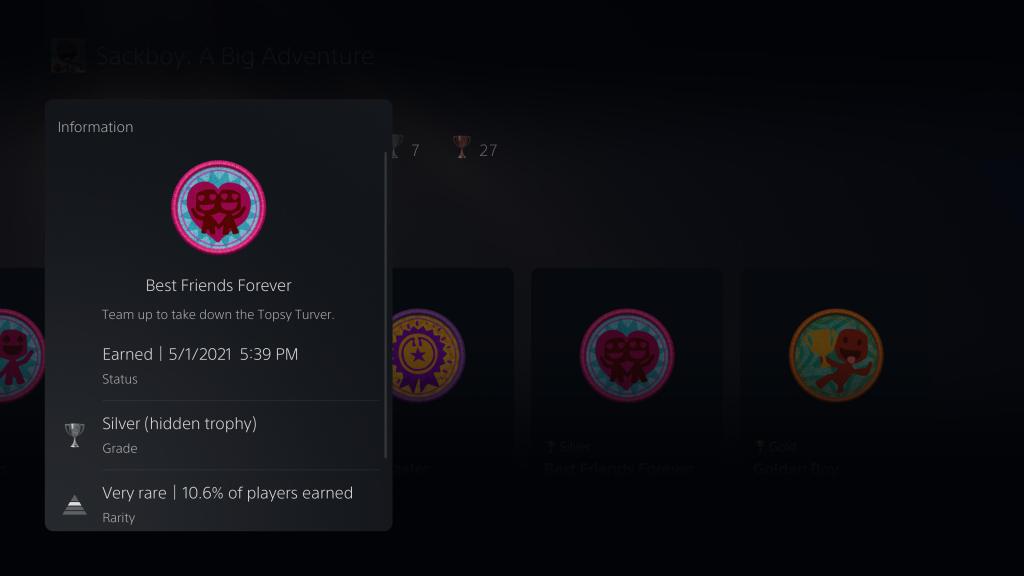
Sackboy is definitely best played with others, when the online servers cooperated that is. Most sessions with my friends online were met with a lot of lag and connectivity issues, but we could never determine if it was one of our connections or the server itself. Regardless, when the game worked, it was always a good time, however. Since this game released during the pandemic and prior to the vaccination rollout, I would imagine it would have been more fun to experience the game locally with friends, siblings, or significant others. Sackboy also released during the transition/launch of the new hardware (the PS5 and Xbox Series X/S, respectively), so it feels like it go lost in all of the initial chaos. With that said, the PS5 version does utilize the DualSense controller to a degree, although it’s not as impactful as say Astro’s Playroom (but no game has made use of the controller quite as well as that game did, and that was both a pack-in and a launch title!). I completed the game with mostly everything collected, but I’m a ways off from obtaining the Platinum trophy and there’s a post-game world I’ve yet to tackle.
Game #18. Stitchy in Tooki Trouble, developed by Polygoat, is a 2D platformer clearly that’s inspired by the likes of Donkey Kong Country (DKC). They say imitation is the sincerest form of flattery and that’s honestly the best thing I can say about this game. Stitchy is perhaps the slowest moving character I’ve ever played in a 2D platformer. Unlike Donkey Kong and his gang, Stitchy has no forward momentum/roll and outside of a double jump, it feels like you’re dragging around a lifeless corpse at times. Not to disparage mobile games, but it feels like a game that was aggressively made for mobile devices (I believe the developer has a history on these platforms, too). The level design is flat, uninspired and rarely offers any sort of verticality. You could replace one stage for another and outside of some visual differences in the background art, there’s not a whole lot to write home about here. There are mine cart levels and barrel blast-focused stages, however, which add some much needed variety to the game, but it’s nothing you haven’t seen before.
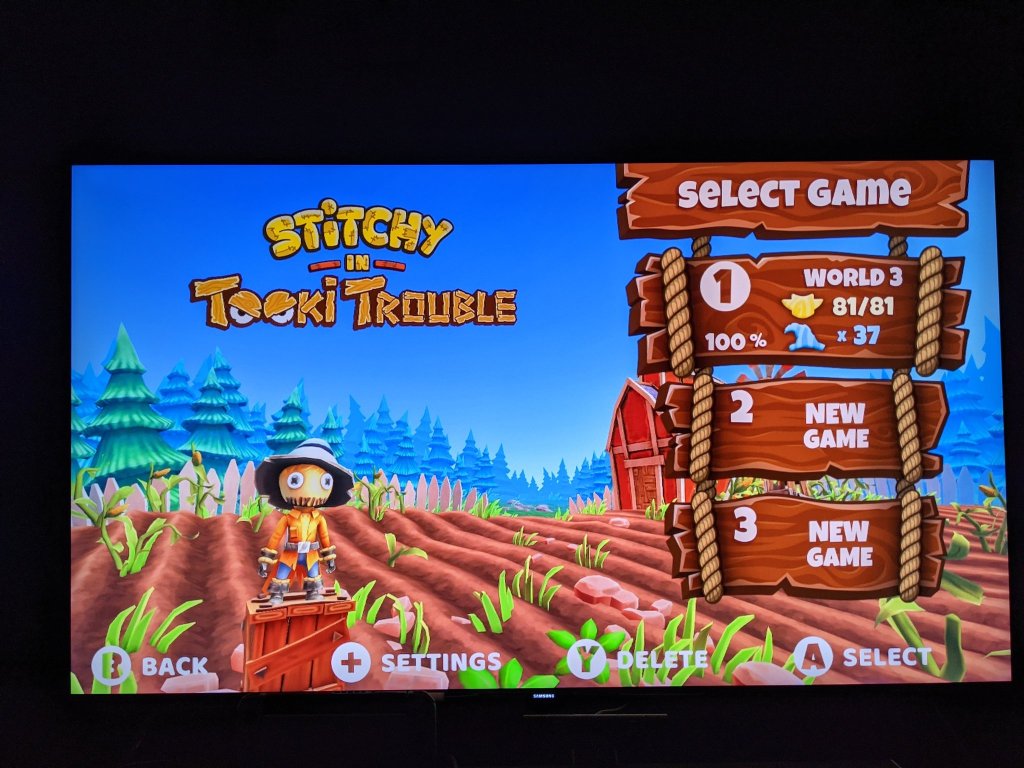
I don’t often like to dwell on negativity and there’s certainly a framework here that the developers could build from. The game could have been far more interesting if it perhaps leaned more into the fact that you’re playing as a scarecrow (not that scarecrows are super interesting, but hey, I’m not the designer here!). The story setup is rather strange, too; a bunch of tiki statues storm a corn field and steal all of the stalks where Stitchy is guarding… so that they could make popcorn at their factory to watch a movie? Sure, why not. I completed the game at 100% and while you could do far worse, there are much better 2D platformers and DKC-likes out there, one of which I finished and wrote about below…
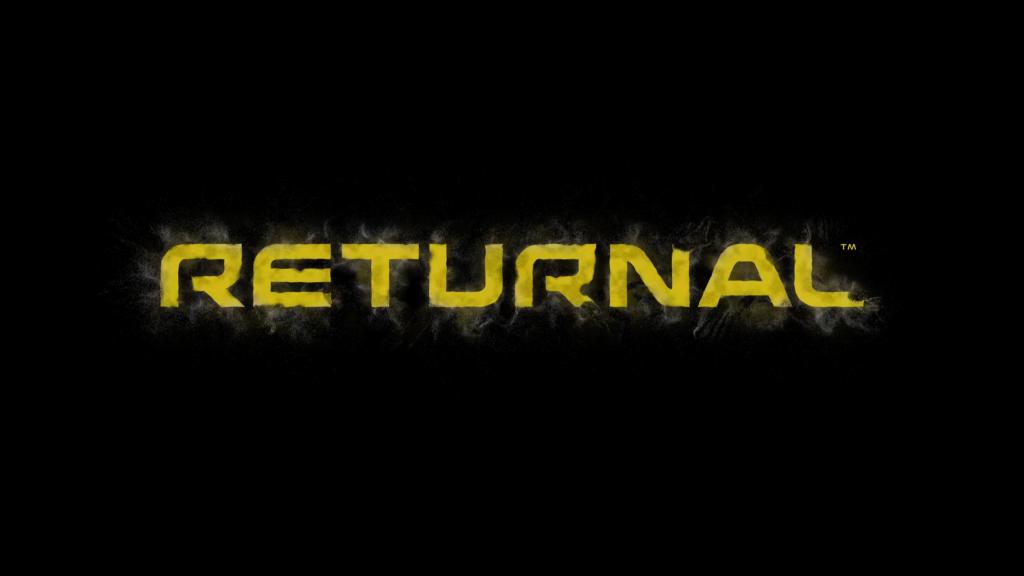
Game #19. Returnal is arguably Housemarque at their finest. Their signature arcade gameplay returns in one of their most ambitious games to date. Returnal takes the now popular Rogue-light genre of sorts and presents it in true “AAA” production with cutting-edge visuals and sound design. In Returnal, you play the role as Selene, an astronaut who’s crash landed on an alien planet. The twist here is that upon her death, she repeats the same crash landing sequence over and over again in a groundhog day style scenario. As she explores the alien landscapes, she finds herself experiencing flashbacks and visions from what appear to be from her past, present and future. She also finds her body strewn about the environment from her previous attempts at survival on this hellish world; it’s all rather dark and depressing.
Returnal has had an interesting launch period, to say the least. Leading up to its release, this was Housemarque’s reentry into the traditional game release hemisphere, so to speak. After Matterfall in 2017, Housemarque hit a bumpy road or two and claimed they were done with their traditional, arcade-inspired titles (they even wrote a letter to their fans, which you can read about here). A battle royale game was in development, called Stormdivers, which has yet to release (and may have already been canceled?). Fast forward to 2021 and we now have their first “AAA” game that also happens to stay true to their arcade roots sensibilities. Stranger things have happened, but I’m glad this developer is back doing what they clearly know best.

The Rogue (or Rouge-like) sub-genre has been around for ages, but it’s become more popular, especially amongst the indie developer circuit. Games like Hades, by Supergiant Games, has propelled the sub-genre into an entirely new stratosphere, for example, so it was only a matter of time before a larger, “AAA” studio like Sony/Housemarque would make their attempt. With that said, the effort here doesn’t feel forced or a response to the current trend, however. Returnal does have all of the usual Rouge-like trappings; run-based sessions, loss of power-ups/inventory upon death, shortcuts that make consecutive runs faster, and passive upgrades that carry between playthroughs to give you some sort of sense of progression. It’s all here, but because of the presentation style and 3rd-person perspective, it all feels fresh and new.
Returnal is quite the experience; dashing around the environment, using the alt-fire/adaptive triggers for each weapon, feeling the rain hit your controller with its haptic feedback and watching the enemies explode into a dazzling array of particle effects never gets old. The sound design is impeccable as well. I played through the game mostly with the 3D audio from my headset and as cliché as it sounds, the environments felt like they were alive and breathing. The adrenaline rush you get when you dash into a room that locks-down and spawns waves of monsters, hearing their screams from every corner of the environment, there’s nothing else quite like it. Returnal is arguably my favorite 3rd-person shooter since Platinum Game’s Vanquish, which hasn’t been personally dethroned in years.
Finally, now that I’ve had some time to reflect on the game, I’m finding myself comparing it to my time spent with another first-party PS5 title that has recently released, Ratchet & Clank: Rift Apart. On the surface, they’re both third-person shooters with dash mechanics and a fixation on devastatingly powerful guns. While R&C has always been known for its wacky arsenal of sorts, I found myself enjoying the gunplay here more than the game/franchise that’s mostly been known for its 3rd-person shooting. I completed the game with the initial ending, but there are still perks to unlock on weapons, artifacts to discover and collectables to earn in order to see the “true” ending. You can be sure that I’ll be returning (see what I did there?) to this game often until I secure the Platinum trophy in the near future.
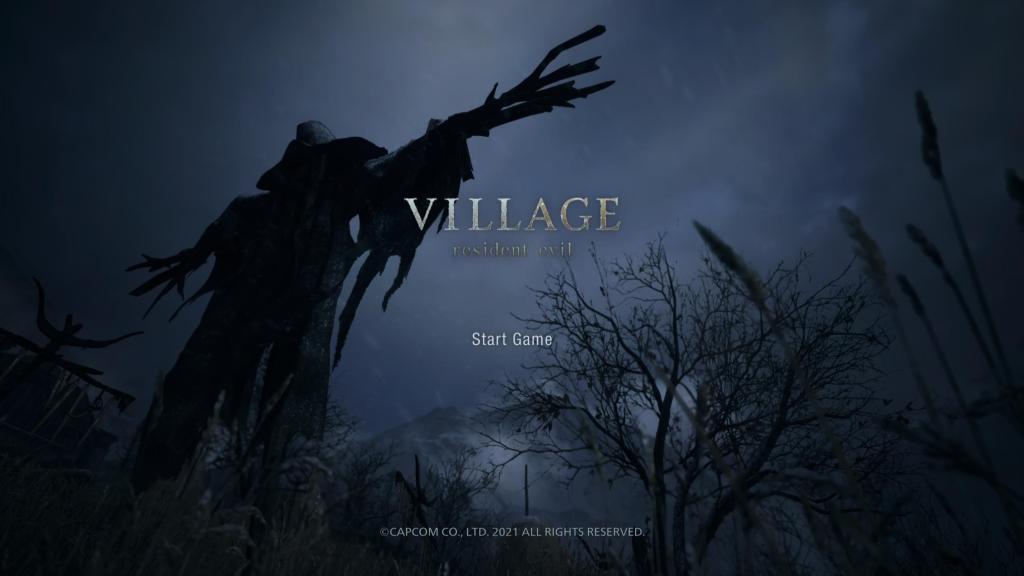
Game #20. Prior to the release of Resident Evil VII (RE7), the franchise was treading in some rough waters. RE6 and Operation Racoon City, just to name a few, set the series off-course for many fans, including myself. One could argue that the franchise was headed in the wrong direction since RE5, as it paled in comparison to RE4 (despite being one of the best cooperative games for its time). Now, we’ve arrived at Resident Evil Village and although it’s not as impactful or groundbreaking as RE7 due to its lack of PSVR support, it’s still an incredible follow-up and a notable (if not relatively safe) entry in a long-running series that clearly has a lot more to say. RE7 felt like a reboot of sorts with it being the first, mainline RE title to go first-person (if you don’t count the Gun Survivor games). RE7’s atmosphere is still unparalleled and while Village doesn’t quite capture the isolated, creepy atmosphere of the previous entry, it’s not without its scares. Without spoiling anything, Village essentially pays tribute to the entire franchise. It’s a roller coaster of sorts that takes the player on a wild ride through what feels like an assortment of amusement park attractions. It’s got the action-packed encounters, variety and superb pacing from RE4, the mansion-like design (specifically in the starting castle area) which harkens back to the first game and the weirdness you’d come to expect from some of the more esoteric entries like Code Veronica.

The “tall lady” made quite the splash on social media to the point where most people believed she was going to be the focal point of the game. Sure, the vampire-adjacent villains were mostly memorable and the performances were great, but there’s so much more to Village than what we were lead to believe, at least in terms of how the game was shown prior to release. Capcom unintentionally played us all and I’m happy the rest of the game wasn’t spoiled in pre-release footage/details. Village takes you to a ton of different locales/environments, with a central town that acts as a hub town which branches outwards. There’s secrets, hidden areas and other collectables to find throughout the many areas you’ll visit, but most importantly, it all somehow feels tightly woven together and relatively cohesive. The enemy variety and combat encounters are mostly good too; monsters will duck and sway away from your shots and I believe you can even duck to avoid grabs, which gives the player some decent movement options considering it’s a first-person shooter at its core. The guns mostly feel great to use as well and much like RE4/5 before, they can be upgraded with money you earn by selling treasures you collect along the way (although, there’s nothing here that feels quite as satisfying as reloading the bolt-action rifle from RE4).
One of my favorite moments playing Village? Exploring the castle, managing my resources, getting stalked by the tall lady and rushing into the save/safe room to restock my ammo and save my progress. This is what makes Resident Evil, Resident Evil for me personally and for that reason alone, I loved the game. I’m not quite sure where the series is headed, but an RE9 is inevitable and I’m hoping Capcom closes strong on this new trilogy of sorts. I completed Village on Normal difficulty, but there’s still a ton of unlockable goodies and harder difficulties to tackle (including recently announced story DLC!). If you’re a long-time fan or a newcomer to the franchise, Village is one of the best games of the year, hands-down.

Game #21. What’s there to say about Super Mario Galaxy (SMG) that hasn’t already been said? A few months ago, I completed a replay of Super Mario Sunshine (which you can read about here) from the Super Mario 3D All-Stars collection, so a SMG revisit was long overdue as well. I’m not quite sure if SMG is my favorite 3D Mario title, but it’s certainly up there on my list. The level design is superb, the soundtrack is phenomenal and it’s simply a joy to play still. After all of these years, the gravity-defying gameplay still somehow feels novel. If there’s one super minor thing I don’t like about the game, or rather, something I would change, is the fact that it’s missing the traditional 100 coin Power Star challenges for each world (and I don’t mean the purple coin challenges you unlock over the course of the game). I like collecting things in 3D platformers and finding the right Power Star objective in the previous two entries to net you that 100 coin Power Star secret in each stage was something I always looked forward to completing. I’m also really hoping Nintendo ultimately releases Super Mario Galaxy 2 for Switch as it remains to be a very strange omission from the collection. At the end of the day, I completed the game again with all 120 Power Stars and 9,999 Star Bits collected (for that sweet, sweet watermelon unlock).
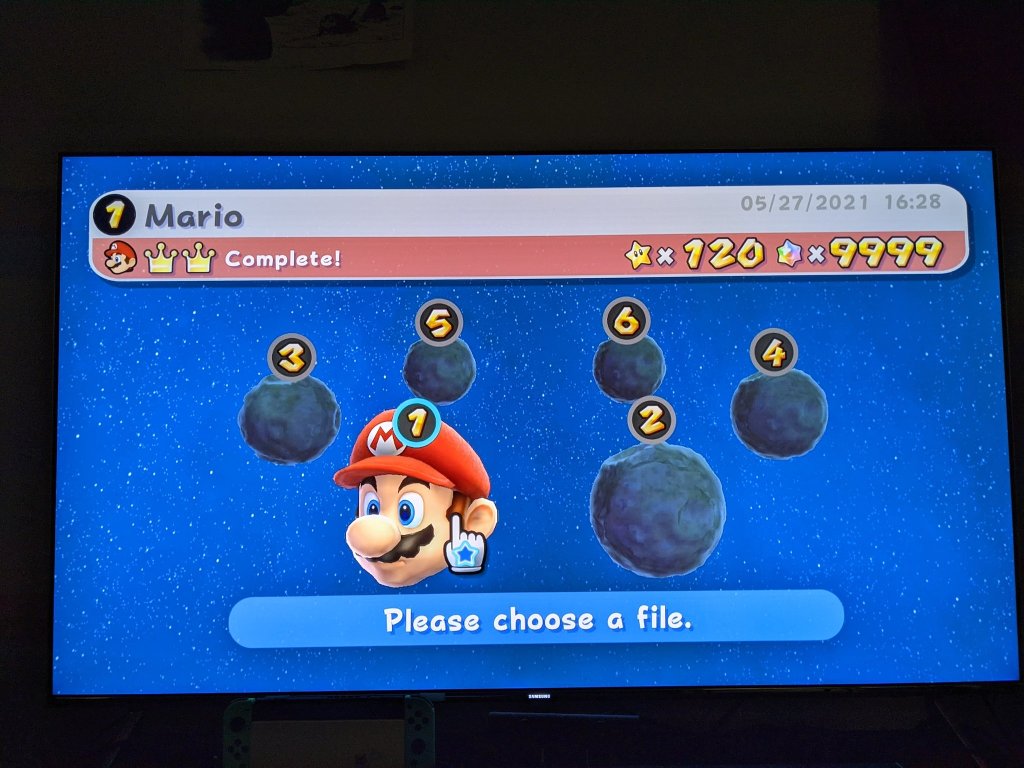
Game #22. The Pathless, by Giant Squid, is the follow-up to their last game, Abzu. It’s a semi-open world adventure game that’s clearly inspired by the likes of Shadow of the Colossus (SotC) and The Legend of Zelda: Breath of the Wild (BotW). Similar to Abzu, there’s little to no spoken dialogue and instead, the game opts for a more minimalist approach. While there’s spirits and murals to read in order to gain a better understanding of the story, most of the narrative is told through the environmental storytelling. One of the best thing about the Pathless is the character movement/speed, however. Dashing across lush, beautiful fields while shooting your arrows at charms (which give you a speed boost) felt far more satisfying than anything else the game had to offer. The game’s rather non-linear, too. You’ll explore segments of an island, solving what can be best described as BotW-like shrines, which give you collectables that are required to access the boss of the area. This process repeats itself for the majority of the game with each puzzle/area escalating in difficulty.

The boss encounters (which are some of the more memorable moments in the game) mirror SotC, in a sense, although you’re not exactly scaling them. Each boss must be tackled on-foot first by shooting weak-points on their bodies before entering a traditional, boss-like arena where you’ll fight them one-on-one. The actual boss fights themselves feel like something out of a Zelda game, however. There’s also a lot of environmental secrets to discover and a lot of them reminded me of the types of puzzles you’d find in The Witness or even the Korok seeds from BotW. As you collect and discover more of the game’s secrets, you’ll gain the ability to fly farther and jump higher (similar to the feathers you collected in another indie title, A Short Hike), which gives you access to even more hidden areas and puzzles to solve. The Pathless was a slow burn at the start, but after a few sessions, the game finally clicked. It clearly wears its inspirations on it sleeves, which isn’t necessarily a bad thing. I ended up completing the game at 100% with the Platinum trophy earned and I cannot wait to see what these developers do next.

Game #23. Kaze and the Wild Masks, developed by PixelHive, is the best DKC-like I’ve played in a minute. It’s a 2D platformer through and through, but an exceptional one at that. It nearly captures what makes both the original DKC trilogy by Rare and Retro’s more recent Donkey Kong affairs so good. Just like in DKC, there’s “KAZE” letters to find (ala “KONG” from DKC), 100 plus gems to collect and bonus rooms to discover in each stage. Going for 100% is certainly challenging, but fair and rewarding. The art-style and spritework is great, too. Kaze has a lot of personality as she’ll use her ears to grapple ropes or blow-up her cheeks underwater to breath. It’s small details like this that aren’t completely necessary, but go a long way in showing that the developers really cared about their game and its main character. The background art is also very detailed and colorful, there’s even a good amount of parallax scrolling on display here which is almost required in any modern-day 2D game.

The stage flow is superb and you’ll realize how great the level design is once you start attempting the game’s time trials. Each stage also has unique platforming ideas and they’re hardly repeated. One stage may make use of ropes while another will introduce bouncing jelly pads which launch your character to greater heights. The levels are also short and sweet, highly replayable and never overstay their welcome. Kaze and the Wild Masks checks almost every box for me personally when it comes to 2D platformers. More so than the original DKC trilogy, Kaze and the Wild Masks reminded me of the types of platformers we received in the early 90s; games like Rayman, Klonoa: Door to Phantomile and Astal (if you remember that one from the Sega Saturn!) come to mind. If you had to play just one indie 2D platformer this year, however, Kaze and the Wild Masks is my highest recommendation! I completed the game at 100% and I can’t recommend it enough if you’re a fan of the genre.

Game #24. Ratchet & Clank: Rift Apart, developed by Insomniac Games, is a phenomenal, yet familiar showcase of what the PS5 can currently offer, both in terms of visuals and the power of the SSD. When the game flexes its dimension hopping capabilities (which essentially eliminates load times as the player will be transported instantly to a new environment), it truly felt like the first, authentic next-generation experience. Unfortunately, outside of a few set-pieces during the main campaign, the in-game “pocket dimensions” were essentially short challenge rooms with little visual flair, challenge or creativity. The story plays with the idea that there are alternate versions of every character in the universe and if you’re a fan of the series, there are plenty of cameos and callbacks to previous titles (although spotting these references isn’t necessary, as it’s perfectly welcoming for newcomers as well). The series is also known for its wacky and outrageous arsenal of guns and the weapons in Rift Apart, outside of a few, felt mostly tame in comparison to previous entries (or perhaps after so many games, it’s hard to feel surprised).
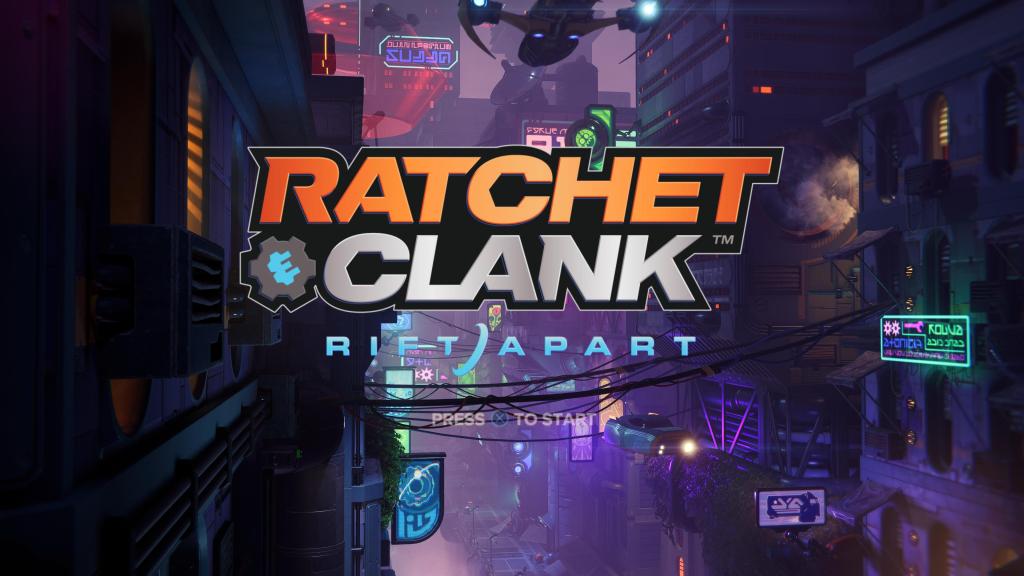
I don’t want to come off sounding too negative, however, as there’s a lot that I loved about the game. Rift Apart utilizes the adaptive triggers on the DualSense quite well as each weapon has half & full trigger alt-fire depending on how much pressure you push down on the triggers. To put it simply, firing guns in a R&C game has never felt better. With that said, I do wish the enemy variety was better. While they’re designed with a consistent theme in mind, the robots/baddies you fight along the way don’t really require you to make use of all of your weapon’s capabilities. I was playing on the second to last difficulty and I could essentially employ the same tactic during every combat encounter; throw your turret-based weapons on the ground first, then unload the rest of your arsenal until you run out of ammo. R&C games aren’t really known for their difficulty, but it would have been nice to see an enemy or two require more experimentation with your arsenal.
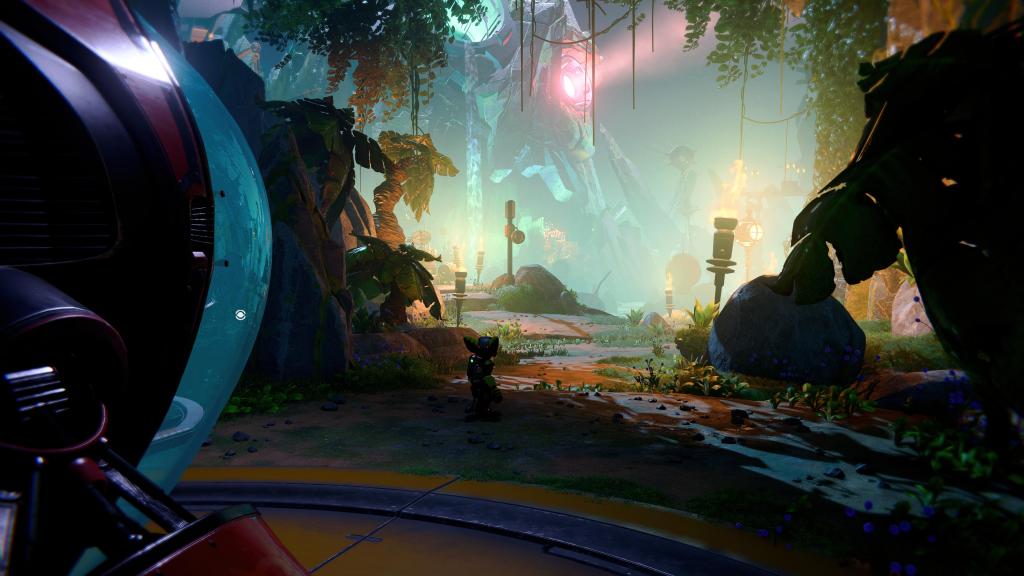
Rift Apart is quite the looker, to say the least. The environments are colorful, densely packed and meticulously detailed. One of my favorite things about R&C games is when you first arrive/land on a planet. As soon as your player jumps out of their ship, the camera is positioned further back to give the player a more scenic view of the environment. If you move either of the analog sticks, however, the camera will snap back behind the player to its default position. While this isn’t something exclusive to R&C games, Insomniac has been specifically employing this camera technique since the original release back on the PS2 and it’s one of the smaller details that I’ve always appreciated about the games. At the end of the day, Rift Apart was an enjoyable, yet familiar ride. Rivet and Kit, the new protagonists in Rift Apart, were both welcome additions to the cast, too. I’d love to see them take the forefront moving forward (with Ratchet & Clank playing support roles, similar to how Peter Parker takes a backseat in Insomniac’s Spider-Man: Miles Morales). I completed the game with nearly everything done/collected and I’ll be revisiting the challenge mode in the near future to mop up the rest of the trophies.
During the second quarter of 2021, I did manage to complete two other games; Ys VIII -Lacrimosa of Dana– (which I started in 2017) and Judgment (which I started in 2019). Currently, I am not counting these two games towards my goal this year (unless I run short of hitting my goal of 52!) because I’ve been playing them on and off since their original release. I loved both Ys VIII and Judgment (which happened to make my 2019 GOTY list even though I didn’t roll the credits at the time), so I may share a few words on them towards the end of the year.
See you next quarter!
-Matty
Sounds good Matt. Glad you are getting around more socially.
LikeLike